Messy. And delicious.
That’s how I’d sum up raising meat chickens.
I guess technically it’s not our first year raising meat birds, as we did have a small test-run last year. But this is the first time we’ve had a larger bunch, so I’m calling it our first “official” year.
I don’t really feel qualified to write a definitive, all-encompassing “how to raise meat chickens” post since we’re still new at this, but I did want to share our experiences. (And I wanted to write everything down so I don’t forget… You wouldn’t believe how often I Google my own blog to remember something.) So here ya go.
We started with 25 Cornish Cross meat chicks this winter and we’ll likely get another 20-25 later in the year. That puts us at about one chicken per week for meals and I feel like that’s plenty, at least for us. (We have tons of homegrown beef and pork to eat, too. Especially beef. SO. MUCH. BEEF.)
Do you love listening to podcasts?
Check out my Old Fashioned On Purpose Podcast Episodes on raising meat chickens:
- Is This Your Year to Start Raising Meat Chickens?
- How We’re Using Chicken Power on the Homestead This Year
- What We Did Differently This Year for the BEST Meat Chickens Ever
- The Inside Story on Getting Chicks
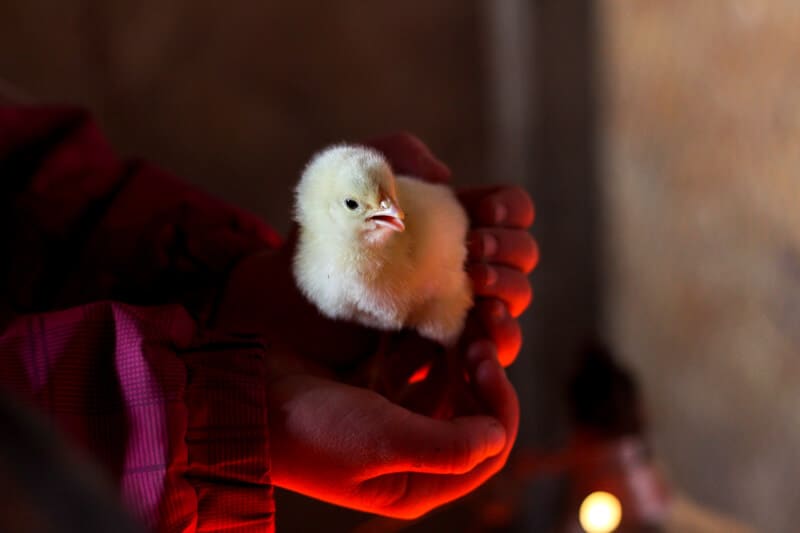
Where to Buy Meat Chicks
We ordered chicks from Meyer Hatchery this year. We didn’t lose a single meat chick during shipping (unfortunately I couldn’t say the same for the Wyandottes we got at the same time, but I don’t think that was the hatchery’s fault) and they were extremely hardy during their first few weeks in the brooder.
There are other larger hatcheries out there as well (Murray McMurray is another common one), although if you are looking at getting heritage meat breeds, you may need to find a specialty hatchery or order from a smaller supplier.
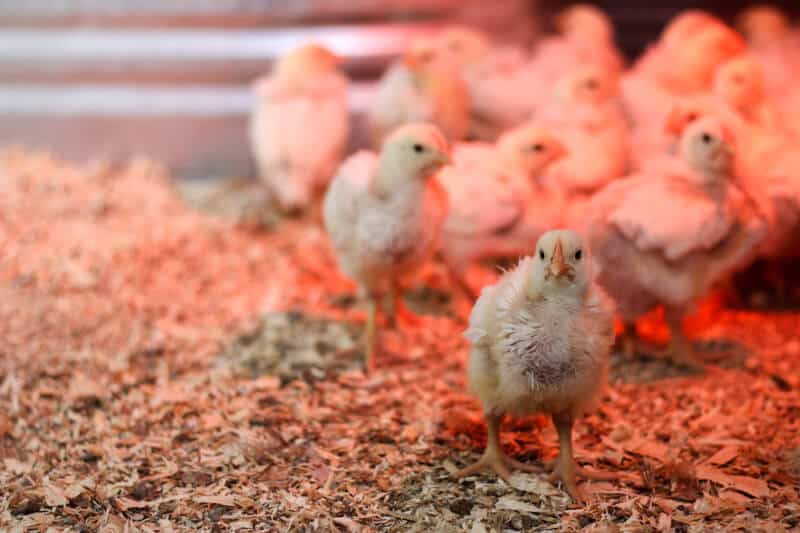
The Meat Chicken Breed Debate
Here I go, getting all controversial again…. (And I only talk about stuff like diatomaceous earth, heat lamps, and chicken breeds. Can you imagined if I blogged about politics? Yeesh.)
After trying both Red Rangers (a heritage variety) and Cornish Cross meat birds during our trial run last year, we decided to go 100% with Cornishes this round.
Contrary to popular belief, Cornish Cross birds are a hybrid breed– not GMO (there’s a big difference). Some people dislike them because they are prone to leg issues (because they grow so fast) but after talking with a number of chicken folks, it seems as though the majority of those problems can be avoided by proper rationing.
During our comparisons last year, we just couldn’t argue with how much more efficient they were– they grew a much greater amount of meat in a shorter time period. So as much as I love heirloom things, this time practicality/economics wins for me…
We didn’t experience any of the horror stories that seem to float around about Cornishes, although we did have two who seemed to have leg issues the last week. (We also were a little late on butchering, so that probably didn’t help.)
Sure, they are a little lazy and they are definitely obsessed with food… But I guess that doesn’t bother me. I wouldn’t like them if I was looking for a new pet, but they are meat animals. Therefore, I’m fine if eating/growing is their main goal in life.
If you prefer Freedom Rangers or Red Rangers, that’s awesome. Isn’t it fun how we can all have our own preferences and opinions? 😉
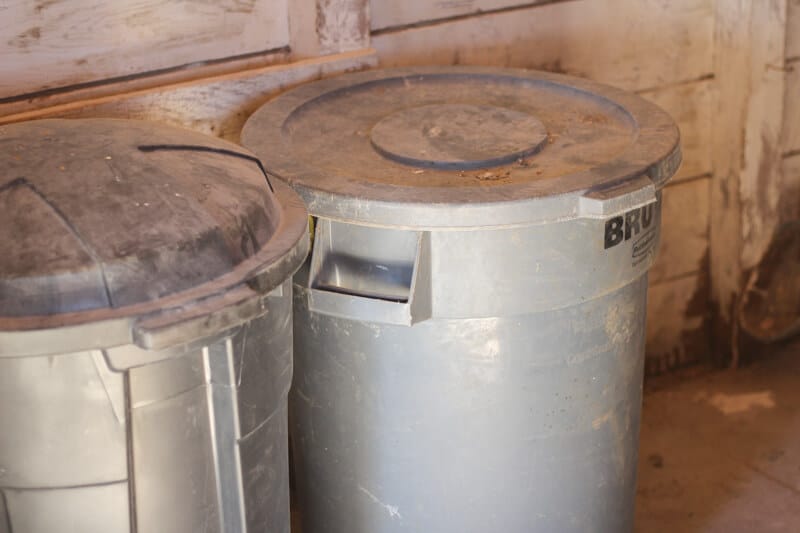
What to Feed Meat Chickens
Spoiler alert: We used unmedicated meat bird starter/grower from the feed store… So if you were hoping for a super-awesome DIY Meat Bird Feed Recipe like the one I have for layers, I’m sorry to disappoint. I haven’t come up with a proper balanced ration yet (proper protein content is important for fast-growing meat birds), so we just opted to purchase feed this time around. Maybe we’ll have something else figured out for the next batch.
I had a number of folks on Facebook asking how much we fed… And when I get questions like this I desperately wish I was more of a numbers person… But alas, I am not. So my answer? I have no earthly idea. We fed a big scoop in the morning and a big scoop in the evening. The feeder would run out in between feedings, which is a good thing considering free-choice feeding for meat birds can cause growth issues.
They had the option to forage/peck around their chicken run, and they did that a little. However, they are not nearly as active as a layer would be, which brings us to the next point:
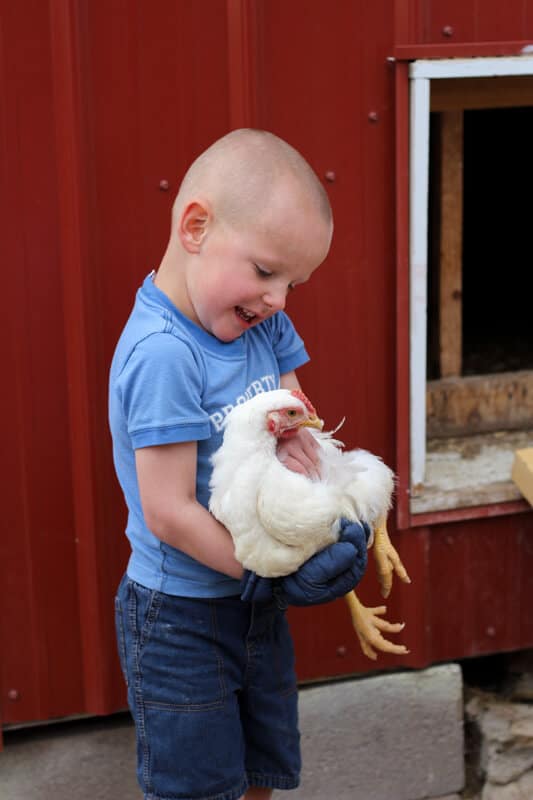
Shelter for Meat Chickens
It took us approximately 1.5 hours on the day the chicks arrived to figure out we could absolutely not keep the laying chicks and the meat bird chicks together. The delicate Wyandotte chicks were no match for the stampeding meat chicks and trampling became a very real concern.
From that point on, we kept the meat birds in a separate brooder, and then transferred them into a bigger pen a few weeks later.
The biggest difference between layers and meat chickens is:
a) Meat birds don’t seem to be nearly as intelligent and therefore are less prone to figure out how to go in/out of a door…Or maybe they just don’t care.
b) Meat chickens poop a lot. Like, a LOT.
This meant their indoor pen would get nasty extremely fast… We had to strip it every other day, lest it get so wet and stinky it was unbearable.
During the last few weeks when the weather warmed up a bit, we would put them outside into the adjoining pen to get fresh air (and also keep them from destroying their inside pen as quickly). It was a pain, though, as most of the meat chickens couldn’t figure out how to go in/out of the door, and we had to move each one individually.
For future batches, we’re planning on making more of a mobile pen or chicken tractor [UPDATE: Here’s a video of our chicken tractor experience!), as stripping the pen every other day isn’t my favorite task…
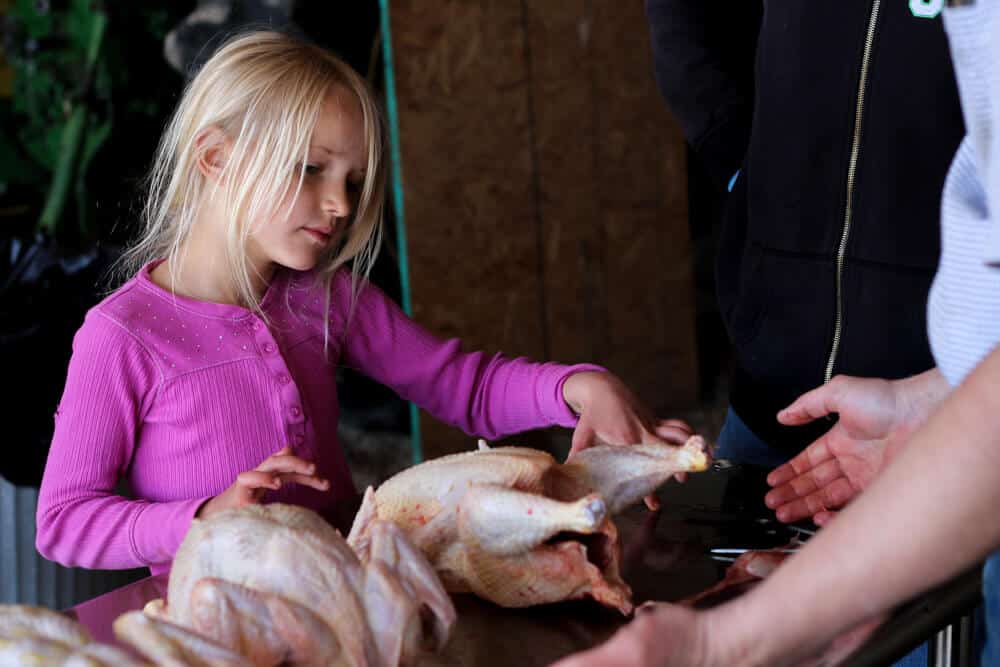
When to Butcher Meat Chickens
Cornish Cross birds are generally ready to butcher between 8-10 weeks of age. Slower-growing heritage breeds will take longer than that (sometimes twice as long).
When you purchase your chicks, be sure to check the calendar and mark when they will be at butchering age, as you do not want to let the chicks too far past that. (Otherwise you’ll end up with leg issues.)
We were at the 9-10 week mark when we butchered our meat chickens, and we ended up with 5-6 lb birds (after processing).
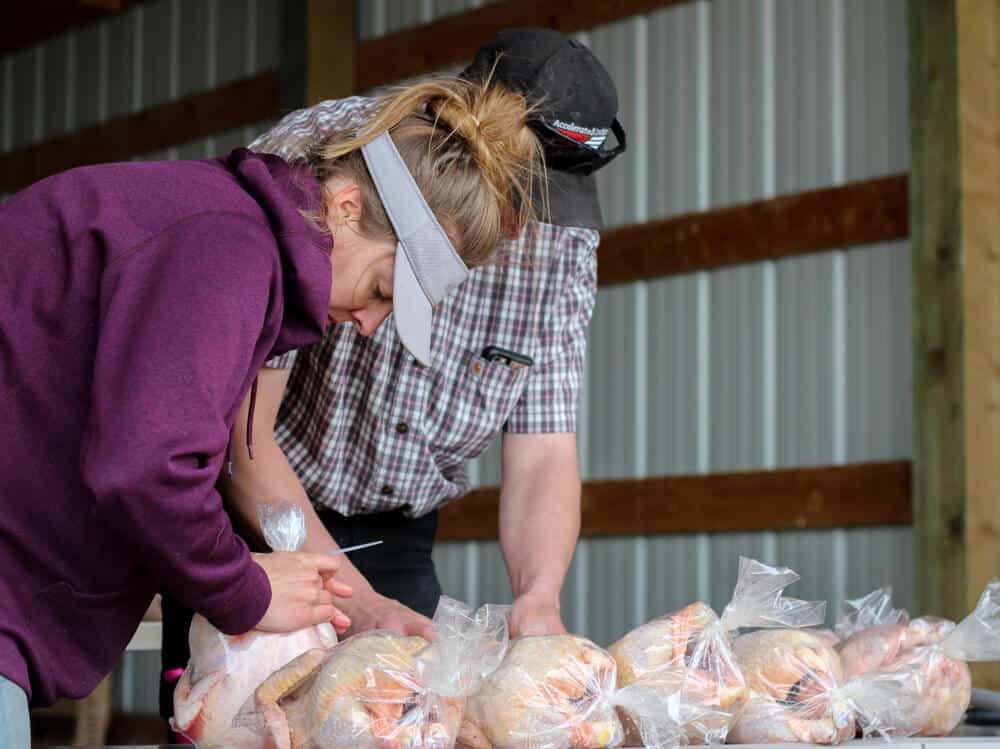
How to Butcher Chickens
Since that’s a whole ‘nother process, I have a separate post with pics for you on how to butcher a chicken over here. And if you’re leery of the emotional aspect of killing an animal you’ve raised, here are my thoughts on that.
We have a few videos on meat chicken butchering day that you might be interested in watching:
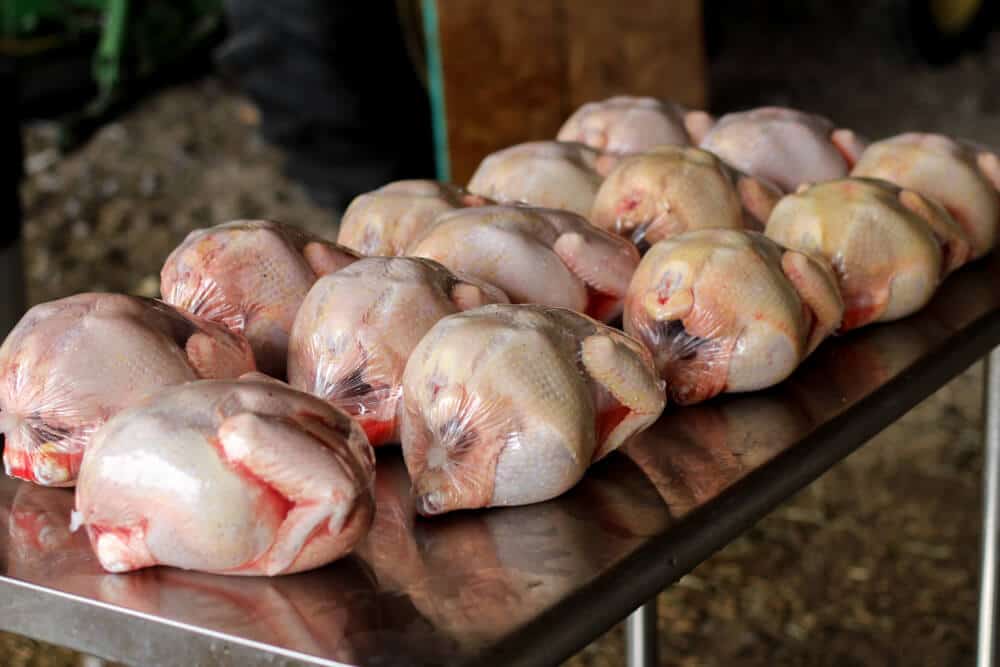
Eating Homegrown Chicken
The very best part… Roasted homegrown chicken is one of my favorite simple meals. I keep my process simple and either toss the whole bird in the slow cooker with seasonings for rotisserie-style chicken, or rub it down with olive oil and herbs and roast in the oven for several hours.
You can also find some delicious from-scratch and easy chicken recipes in my Prairie Homestead Cookbook.
Depending on the size of the chicken and the size of your crew, a roasted chicken will stretch 1-3 meals, plus you’ll have beautiful bones for homemade chicken stock afterwards.
Low on freezer space for whole chickens? Check out the last half of this youtube video to watch me cut a whole chicken into pieces.
Growing your own food is hard, dirty, frustrating, all-consuming, and somehow strangely addictive.
It feels good to master a new skill. It feels good to have a hand in growing the food you eat. It feels good to be a producer instead of just a consumer. It feels good to set a goal, and see it through to the end.
That’s why we continue to do it year after year, and that’s why I don’t think I’ll ever stop. I’m completely and utterly addicted.
Permaculture Chickens
If you’re looking for even more information, my friend, Justin Rhodes, has created the definitive course when it comes to doing chickens the natural way– packed full of actionable information, tutorials, and more! The Rhodes family is the real deal, and if you want to know everything about chicken, this course is for you.
More Chicken Articles for You:
- How to Butcher a Chicken
- Preparing for New Baby Chicks
- Homemade Electrolyte Solution for Chicks
- 15+ Ways to Save on Chicken Feed
- Beginner’s Guide to Chicken Coops
- Fly Control Strategies for the Chicken Coop
- How to Build a Chicken Run
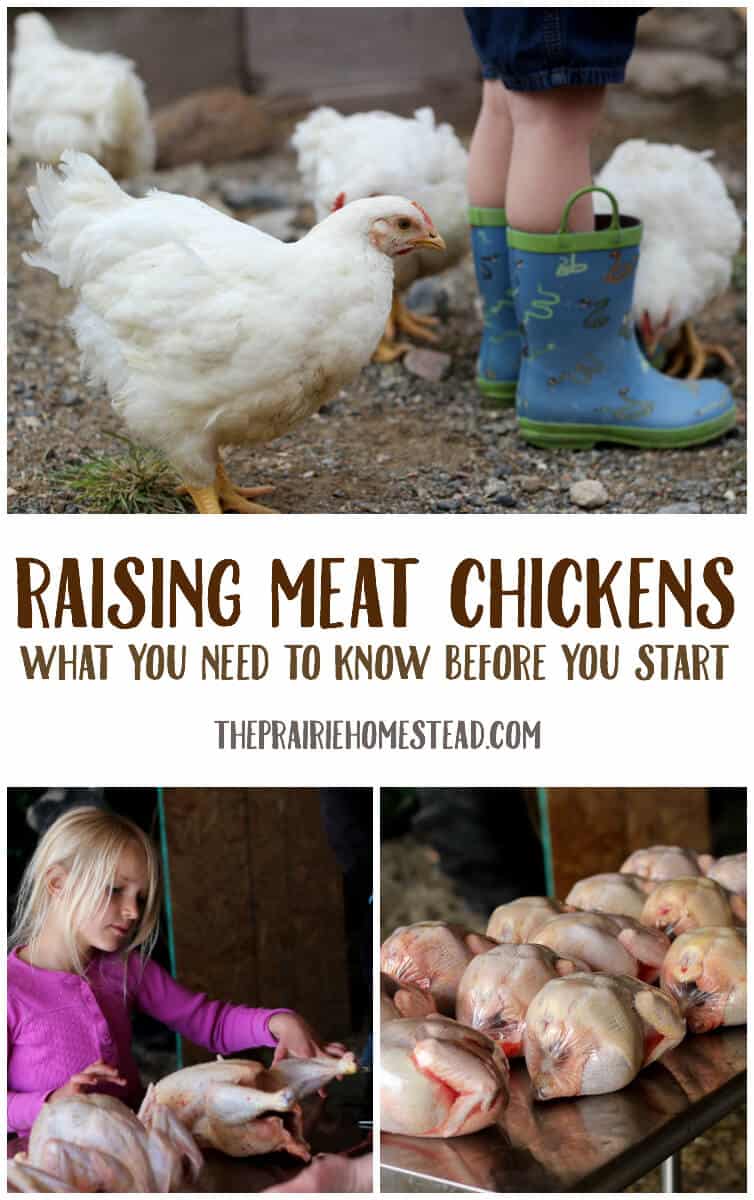


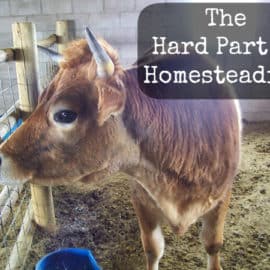
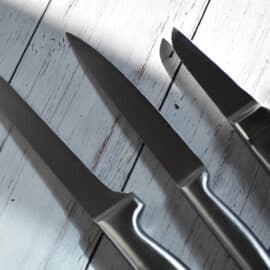
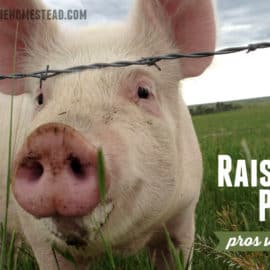
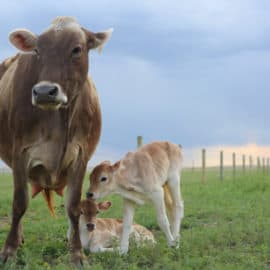
We free ranged our meat birds with all the other chickens. Fed everyone together. I’m the ultimate lazy to be honest. Anyway, they did absolutely fine. I will say they will eat eggs if they figure out they can. So there is that. I enjoyed our cornich X’s. They were friendly enough and the meat output was amazing!
Did they eat layers feed? From what age? I wanted to let them hang out with the other chickens but I couldn’t figure out how to separate the feed…
They did eat the layer feed. The extra calcium isn’t harmful to a bird that lives such a short time. I suppose you could argue they would grow slower without the additional protein but I didn’t find that to be the case. I did feed meat bird feed with calcium substitute for awhile but I found it to be a pointless extra expense.
Perhaps I shouldn’t admit this but my layers are in with my meat birds are in with the turkeys and peacocks and ducks and even pigs when we have them. I fed the pigs different food but everyone eats everyone else’s food anyway. I haven’t had any problems.
This has been my experience. The pigs, goats, chickens, and meat birds all together. Everyone eats everyone’s food. It doesn’t seem to bother anyone.
I currently have 13 of them (5 weeks old). They are good birds but I have to admit they disgust me a bit…. they grow so fast it doesn’t feel normal to me, they poop a LOT like you said, and then they lay down in it, they lazy around all day, they don’t have feathers in some places… I also had to saperate them from the other chicks but not because they stumped on them but because the Leghorns apparently discovered they are meat birds and were pecking them to death! LOL! And they just sit there letting them eat them alive!!
Anyway, I would really love to figure out a sustainable chicken opporation were the chickens hatch their own eggs and grow their own chicks and we still have eggs and meat. I don’t want to keep buying from a hatchery all the time. I’ve been researching for a while and came up with a plan that I think will work. So that’s what I am doing next, hopefully it will work according to plan.
There are dual purpose birds that meet both needs…in general, for meatbirds to reach maturity and produce eggs…they are so large and the hips cannot support the body….it’s a slippery slope. You want more of a dual purpose bird…not. Cornish X
We found putting the feed in the far end of their run with their water at the other end, gets them moving more. Or, i put the water inside the coop, up a ramp for more exercise. Feed was given at 6 am and taken away at 6pm in a hanging feeder so laying down to eat was not an option. Our last batch were 6 to 7 pounds. We feed corn chop with access to bugs, grass and fermented wheat seeds. They even roosted!
Just a note about the cornish crosses, they do not survive at high altitudes. I would much prefer a faster growing bird, but they have heart attacks at 8000′ elevation. So we have Red Rangers or Pioneers. Both of which we have been quite happy with.
I haven’t heard the elevation problem before, but my first experiment with Cornish Crosses resulted in 11 of 12 birds dying of heart attacks here at 7000 feet! So that would really make sense to me. I also free-ranged them, and raised them with a Buff Orpington foster mom, and she flat-out got sick of them for being so lazy. Like many have said, their way of living (eat/poop, rarely move or forage) seemed unnatural to me, and considering the results, I’ll stick with dual purpose breeds. We get ours from Canyon Creek Poultry in Hamilton, MT: she raises home-bred, healthy, happy birds in several breeds she developed just for our northern climate. She sells her rooster chicks for $1 each for meat birds! Mine tend to dress out in the 3-5 lb range, but they seem happier than the Cornish Xs, and are effortless to raise.
WOW! High elevation kills – that’s crazy. Great advice!!
a couple of thoughts:
1. It can be tricky to be sure you don’t end up with meat that is appetizing. Sometimes eating home grown meat chickens is like eating rubberbands. Be sure to process before they get too big & to age (or rest) the meat before eating.
Fresh chicken meat (like butchered that day) is not something anyone wants to eat. LOL
2. Messy is RIGHT!!!!! They are a disaster. Love it.
But home raised meats are the best.
XO,
Candi
That’s interesting information. Who would have thought. Have a question about temperature. When/if one has the birds in a chicken tractor after the brooder stage say at 2-3weeks, what is the coldest temperatures these birds can handle in an un heated environment at that age?
Wow – I am so impressed by what you have accomplished! I’ll live vicariously through your posts I’m afraid, so thank you for sharing your experiences.
We raised Cornish Cross. The Lady we purchased them from had us feed them layer mash on their second bag of feed. She said the extra calcium in that would help with the leg issues. We used a light bulb to come on before dark to intince them to go up the plank into house. Then slid a plexiglass door shut when all were in. In 9 was they ranged from 9 to 11 lbs. I froze and canned it. Also looked up how to clean an process chicken feet. Very healthy.
9 weeks
I just finished my first round of Jumbo Cornish X, yes they are disgusting and lazy. At 8 weeks they dressed out at 9.5 to 12 pounds. After shrink wrap was done they were rested for 24 hours before freezing, selling or being cooked. I have used non-medicated meat bird starter / grower for the duration. And did 12 hours on and off feed. Will do this again in the Spring just fewer birds this time.
You rested them in the refrigerator for 24 hours after you butchered them and then put them in the freezer? What is the reason for doing this? I am about to butcher by first batch of 20 Cornish Cross birds and I have not heard of this before. I have watches several videos on butchering, but no one has ever said to rest the bird for 24 hours. I am not opposed to doing this, just curious what the benefit is. Thanks for your time.
I’m going to raise meat chickens this spring. Should I get them vaccinated?
One thing I learned from my mother in law, is to rinse them in a mild plain soap solution and use a clean brush to scrub them in and out after picking and then rinse twice. We also soaked them in cold water, changing it every twenty minutes, while we did this. Then we dried them and then we bagged them. I notice you have a lot of blood water in the bag– if you scrub and rinse, you have no chickeny smells or blood in your freezer bag.
I was so excited to read this by you because we are looking at getting some meat chickens this year. I have helped raised meat chickens before but I was not the primary care taker and I know there will be a slight learning curve to it!
I hope it’s a great experience for you Laura!
Jill l raised 50 Cornish in an enclosed wire bottom cage IN MY GARAGE (LIVE IN A SUBDIVISON IN CITY)..Built shelf under the cage placed sheet of black plastic on shelf caught droppings (Lots), let dry overnight spread on lawn (got yard of month), after l finished fertilizing would wrap plastic put in garbage bag…let city haul it off with weekly trash. Had 6to7pound birds in 8 weeks, spread a tarp on garage floor…killed and butchered for freezer, wrapped all pieces parts in the tarp carried to city dump and smiled. WANTED YOU TO KNOW I SKINNED ALL 50 BIRDS WITH FEATHERS (NO PICKING) IN 3 HOURS.
Art– you are plain amazing! I am impressed!
This is great and so neat you found a breed that works for y’all. We raised the Cornish cross twice and finally I said to my husband I can’t raise this breed again. Maybe if I would have approached this during the fall and winter when our temperatures are cooler I’d feel differently. We free ranged in 4 x 8 wood framed runs and then had a mobile house attached. There were 8 runs that we moveed so the birds were always on clean grass. Open free range wasn’t possible because the hawks and vulchers arrived, they love birds under 4 lbs. Later I switched to Buff Orpingtons because it was a dual breed that worked and the meat reminds me what chicken tasted like growing up. We order in straight run and then process all the males at about 4 months. The disadvantage is the time frame from chick to processing so I try to do this over the summer when the bug population is the greatest to help detour feed expense. I’m chicken free right right and missing that homegrown goodness.
Interesting– so do you find the Buffs have good meat yields? That has always been my concern with dual purpose breeds
I’ve raised the Cornish x for several years. 2years ago I discovered Hilland natural animal feeds. They are NoN GMO and have chicken starter and layer formulas. I fed the starter for 4weeks then mixed in the layer after that. My birds went outside into a paddock during the day and got the feed when they came in for the night.
We are lucky, we get our Cornish X at the local feed store, (we order ahead of time, this year only 50) and we get their feed there too. We use the feed store’s starter mash and at about 3 weeks start #1 grit and move them to broiler pellet. The feed store/mill makes all the feed there on-site and it’s quality stuff. We also put vitamins and electrolytes in their water clear up to processing time.
We process at 6-1/2 weeks and average 4-1/2 to 5 lb finished product. No leg problems or extra fat that way.
Our barn is set up for easy cleanup, so we no longer use chicken tractors or try to get them out on “pasture”. It was way more work intensive, and the end product failed at times because of it. The big stall they live in gets new thick layers of straw and hay every few days (they are messy!), and when it’s all done we can drive the tractor right in, scoop out the goods for the compost heap (mountain, lol) then pressure wash it all out.
So much of our current practices are based on past failures and/or just trying to make things work easier.
We do not mix the broilers in pens with the layers or turkeys, again learned from experience. Each variety gets their own specific formula of feed for maximum health.
We have happy birds, and they get a lot of loving care and attention during their short stay.
Thanks for the memories! We lived near my aunt and uncle and grandmother. We all had gardens, pigs, beef, rabbits & chickens that we raised for food. Every year, the 3 women and 2 oldest kids (myself & brother) would spend a couple days butchering chickens. These were all free range and came from the hens on the farm.
We had a 50 gallon barrel over a fire with water and lots of buckets. Myself and brother would go into the pen and grab a chicken and wring its neck and toss it into a 50 gallon barrel. Mom, my aunt and grandmother would grab one, dip, pick and put into another barrel until they had a about a dozen then they formed an assembly line to clean and place into another cold water barrel. This was in the late 50’s so, we didn’t have the fancy equipment available today.
My most favorite memory of that time was the one day that my brother (he was about 6 or 7) was helping me wring their necks. He was working so hard and we had about half of the barrel filled when my aunt, a very religious woman, leaned over to grab one and suddenly about 4 or 5 of them flew up at her face and out of the barrel!!! She screamed, dropped to her knees and begin to pray!! We were trying so hard not to laugh. We figured out my brother wasn’t really breaking their necks but rather stunning them by swinging them around in a big circle! It has been almost 60 years but, I’ll never forget the day my aunt decided God brought those chickens back to life and they were going to stay that way! 🙂
I agree: growing your own food is totally addicting! (And I totally google my own blog All. The. Time. That’s the reason I started it! To keep track of my own recipes, ha.) This is our first year for meat birds…we are total newbies. We ordered Jumbo Cornish X Rock from Murray McMurray, and built a chicken tractor a la Joel Salatin. (And when I say “we” I mean my husband.) 😉 I’m super nervous about processing them ourselves. Should be an adventure for sure! (We’re headed to Polyface Farms next week for a walking tour and are hoping to catch some of their chicken processing to bolster our courage.) Thanks for all the details, Jill!
A plain roasted homegrown bird is just to die for. I keep Bresse but the blue tint in the bones can put some people off.
Like you I haven’t managed to get away from a bought commercial feed for chicks or broilers and I’m not sure i will as getting it wrong will be such a problem.
How do you package your birds? We have used a food saver vacuum; however, we had issues with it sealing all the way this year. I am wanting to look into alternative methods. Thanks.
We just got started with chickens in June and have over 150 already! Yikes! Our homesteading beginning animal of choice was the goat. We have 23 goats browsing our 10 acres to helps us clear the underbrush and decrease the fire danger here in NorCal. Although I grew up raising poultry on the farm as a child, this is a completely new ball game doing it as an adult.
Chickens are neat and put themselves to bed. As long as no predators wanting a chicken dinner, they are pretty low impact to add to the homestead farm operation! I own a farm in ME.
We just got our first flock of laying hens last Fall, but I would really like to try some meat birds. I am pretty nervous about butchering them myself though. Your posts help make it feel a little less intimidating!
I haven’t raised chickens for meat yet. I’m currently in the suburbs with some undercover egg chickens. ? But I’m in the early stages of building a farmhouse out in the country, so I’ve been doing my research.
My gut instinct is that Cornish cross are just kind of sad. They don’t forage or move like regular chickens and definitely get a lot of health problems. But I certainly understand the advantages and it’s worlds better than grocery store chicken.
I did just want to point out for your readers though that red rangers are also a hybrid chicken. They aren’t a heritage bird. They act more chicken like though.
If people are looking for a heritage bird, good options are Orpington, Rhode Island Red, barred rock, or Delaware. I like the idea of hatching my own eggs and having the whole process on land. At least that’s the vision, we’ll see how the reality goes! ?
Yeah, the cornish cross are a little sad, but after having 300 this year, they really aren’t that bad! They still forage and chase the chicken who found the snail, scratch the ground, and eat lots of grass! We will do them again next year and aldo try the red rangers to see the difference.
Amazing!! There really is a big difference in taste! We did 300 this year, and loved it.
I’ve raised so many breeds of chickens, both meat and egg, in the past. When we’ve butchered chickens it’s always been Cornish crosses. You just really can’t beat the growth that you see in such a short period of time. We’ve butchered a few dual purpose chickens before (probably too late) that were problem chickens and found the meat was rubbery and that there wasn’t much of it. I’ve done the math before and figured out that raising meat chickens saves us personally about 40-50 cents per whole chicken in the end. It doesn’t sound like much but it adds up. Plus you can’t beat the taste. Has The last round of Cornish crosses we harvested had some places on their stomachs where the feathers had rubbed off. I know that can happen and isn’t much of a concern, but I had two that laid around so much that not only did they rub the feathers off of their chest, but they actually caused sores. I had to cut this part of the chicken off when we processed. Has anyone else had that problem?
I’ve also got a similar post about what we learned the first time we raised meat chickens. If you’re on the fence about raising them, just jump in and go for it!
Chicken raising is my favorite job. I really like taking care of chickens and watching them every day.
Good article.
MOST people in the US today believe that food comes from the grocery store. They have no clue about what happens before the grocery store; and consequently, they have no idea where that food came from on the shelves. Sad state of affairs, but it is what it is?
We are preparing to start farming chickens, for the whole process and product (eggs & meat). They will also give me some pest control at my home (bugs and such); but I will need to protect them (coyote and hawks). It will be a fun learning process!
Thanks!
My friend raises Cornish Rocks and they have figured out the shelter problem by making more of a lean-to situation. Basically one entire wall of the “shed” they built is a plywood “door” on hinges at the top that props up for additional shade. They also put a window in the back of the “shed” that can be closed or open to create a cross breeze in really hot weather. There is basically just enough room for the chickens to lay down and sleep inside and then doubled, and most of the time during the day they are out in the grass in the shade (created by an old trampoline tarpon). They very rarely have leg issues, and love eating the fresh-picked grass give to them when they run out of their own in their enclosure. The “shed” encloses completely when the door is shut (it’s maybe 7 ft high), so the birds are protected from the weather and animals at night. They just have a fence enclosing them which can be stepped over, so less protection from animals, but they are close to the house and there are dogs and people around.